Military Order of St. George, Knight's Cross
SKU: 01.BAV.0103.106.01
Estimated market value:
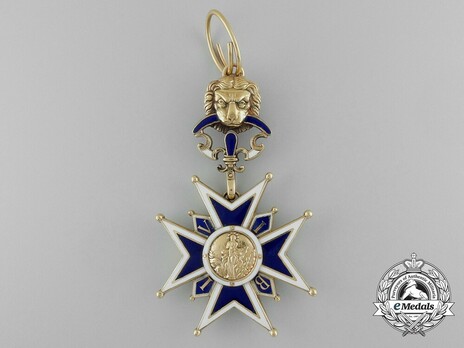
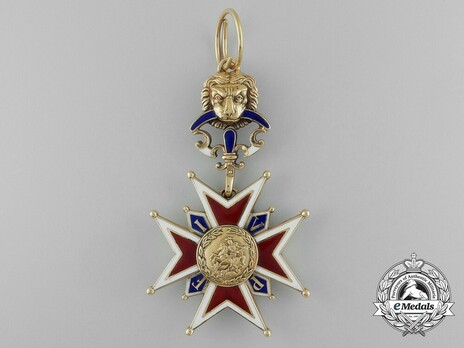
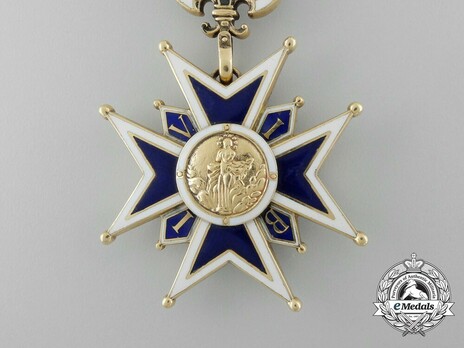
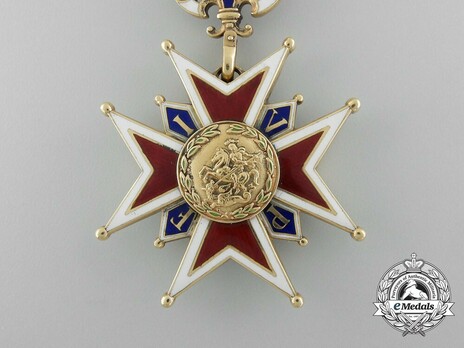
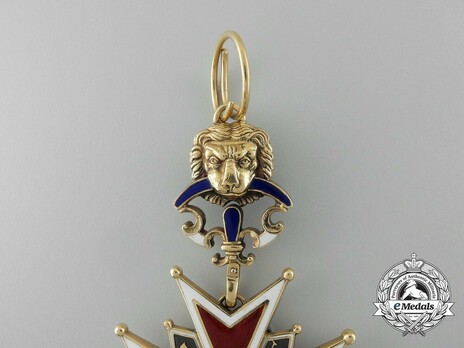
Estimated market value:
Attributes
Physical Description
A gold and enamelled Maltese cross, the arms with white enamelled borders. The points of the arms host small round gold finials and there are blue diagonal lozenges in the quadrants between the arms. Each lozenge bears a gold letter “V I B I” which represents “Virgini Immaculatae Bavaria Immaculata" (Immaculate Bavaria for the Immaculate Virgin). The obverse centre medallion bears the image of the Virgin Mary within a white enamelled border. The reverse bears the same design, except the cross arms are in red enamel and the lozenges in the arm quadrants host the letters “I V P F”, representing “Iustus Ut Palma Florebit” (Distinguished for Justice and Glory). The reverse centre medallion bears the image of St. George slaying the dragon within a green enamelled laurel wreath. The suspension is a lion head holding a blue reverse crescent shaped handle in its mouth. The ribbon of the order is light blue with narrow dark blue and white stripes near the border.
History
The institution of the Military Order of St. George has been disputed by various historians, but most sources state that it was on March 20, 1729 by Elector Charles Albert of Bavaria. The tradition of loyalty to St. George, the patron saint of chivalry, had been long established in Germany before the institution of the Military Order of St. George. In the fifteenth century, Bavarian princes made the pilgrimage to the Holy Sepulcher and were invested as knights as they made a promise to St. George. The decision to found the order may have potentially been influenced by the Wittelbach family's failed attempt to acquire the Grand Magistery of the Sacred Military Constantinian Order of St. George, which had been recognized in 1701 by the Holy See as pertaining to the Italian Farnese dynasty. Elector Charles Albert established the order as a Military Order of Chivalry for Roman Catholic noblemen. It was divided into three classes: Grand Commander, Commander, and Knight.
In order to qualify as a knight of the Military Order of St. George, one had to prove a minimum of 17 noble ancestors from their paternal line and 17 noble ancestors from their maternal line (approximately 300 years of ancestry). No merit was required to receive the award other than proving one's noble family lineage and being Roman Catholic. It was common for the order to be awarded during religious festivals pertaining to St. George on April 24.
In 1741, the order was reformed and a clerical class was introduced - also limited to those with noble ancestry. The clerical class included a Bishop, Provosts, four Deans, and Chaplains. On February 25, 1827, Ludwig I declared that the King was to always be Grand Master, the Crown Prince the first Grand Prior, and the other Bavarian Princes second Grand Priors. The statutes established six Grand Commanders, twelve hereditary commanders, and unlimited knights. The statutes were revised again on December 11, 1899 and the clerical class was suppressed (although clerical members could still join as regular members provided they had the necessary noble ancestry). The regulations were simplified and members were required to be at least twenty-one years old, and examined by a committee of knights before admitted.
The current Grand Master of the Military Order of St. George is Franz Herzog von Bayern. The requirement of noble ancestry is still strictly enforced. There are about ninety present day members, and the Order celebrates its feast days on April 24, Saint George's Day, and December 8, the Feast of the Immaculate Conception.
The Order consists of a Collar, Grand Cross and Grand Cross Breast Star, Commander Cross and Commander Breast Star, Knights Cross and Knights Breast Star, Officials Cross, and Jubilee Medal.
The cross of the Order is a blue enamelled gold Maltese cross with white enamelled borders. The points of the arms host small round gold finials and there are blue diagonal lozenges in the quadrants between the arms. Each lozenge bears a gold letter “V I B I” which represents “Virgini Immaculatae Bavaria Immaculata" (Immaculate Bavaria for the Immaculate Virgin). The obverse centre medallion bears the image of the Virgin Mary within a white enamelled border. The reverse bears the same design, except the cross arms are in red enamel and the lozenges in the arm quadrants host the letters “I V P F”, representing “Iustus Ut Palma Florebit” (Distinguished for Justice and Glory). The reverse centre medallion bears the image of St. George slaying the dragon within a green enamelled laurel wreath. The suspension is a lion head holding a blue reverse crescent shaped handle in its mouth. The ribbon of the order is light blue with narrow dark blue and white stripes near the border.
The officials of the order wore a special heraldic cross, like the former Maltese cross, but with the central medallion bearing the red cross of St. George on a white background. The 12 and 6 o’clock arms of the cross bear a gold lion rampant on a black enamelled background and the 9 and 3 o’clock arms bear three blue lozenges on a white background. The lozenges in the quadrants of the arms bear the letters “I V I B” on a blue enamel background, but with no white borders. The cross has the same lion head suspension as the cross of the order.
The breast star is a Maltese cross constructed of silver and enamels. The arms of the cross are blue with white borders and the lozenges in the arms' quadrants consist of two white and two blue lozenges. The centre medallion bears the red cross of St. George on a white background.
On formal occasions, such as feast days, the cross is worn by members of the first class (Grand Masters, Grand Priors, and Grand Commanders) from a gold collar. There are three different types of links forming the collar. The first link is in the form of a gold rectangle, the rectangle bears two or three letters which make up the motto of the order “IN FIDE JUSTITIA ET FORTITUDINE” (In Faith, Justice, and Fortitude) with gold Bavarian crowns on either side of the rectangle and red flames at the top and bottom of the rectangle. The second link consists of two lozenges subdivided by white and blue lozenges. The third link is in the form of two gold lions rampant combatant standing on a gold scroll, each lion with one paw on a central white column topped with a gold orb and cross. The left lion bears a torch in its paw, while the right lion bears a sword.
In ceremonies, the first class of the order used to wear a white satin tunic with embroidery down the front and around the bottom hem in silver thread. The embroidery consists of a design of conjoined pairs of oak and olive wreaths with alternating olive branches. There is similar embroidery on the sleeves. The breast star of the order was embroidered on the left breast. There was a blue velvet mantle with the same embroidered design. In the present day, the first class wears the collar of the order over a blue velvet calf length mantle without any embroidery except the breast star embroidered on the left breast.

Versions
$7,500 USD
Gold/Enamelled
Obv: VIBI Rev: IVPF
50x85mm


Comments
Sign in to comment and reply.


Scroll Top